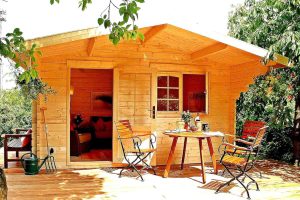For homeowners, moisture buildup can cause the biggest headaches. Mold grows on drywall and wood-based materials, creeping along walls, floors and ceilings. Building materials begin to erode and rot. As insulation becomes damaged, the home’s energy-efficiency decreases. Even human health suffers, as moisture also leads to air-quality issues.


ORNL buildings researchers, from left Philip Boudreaux, Rui Zhang, Stephen Killough and intern Mercy Sammy, demonstrate how a microwave radar system can detect moisture in a wood panel. Credit: Carlos Jones/ORNL, U.S. Dept. of Energy
The key to preventing extensive moisture damage is discovering it early, when it can be easily fixed.
Researchers at the Department of Energy’s Oak Ridge National Laboratory are using microwave radar reflection to nondestructively detect and measure the moisture content of materials within walls without removing drywall or cladding. This also expedites moisture identification and enables mold growth to be treated in the early stages.
“We know microwave radar shows great promise for this, because it’s well known that it can measure the moisture in wood samples,” ORNL’s Philip Boudreaux said. “But can it measure moisture in wood that is inside a wall to detect high-moisture issues before they become a big problem? That’s the challenge.”
A leaky seal
The envelope of a building consists of exterior walls, the roof and foundation, all of which join to prevent moisture transmission. But the envelope is itself prone to moisture issues caused by many factors: too much rain, ground dampness, air leaking through holes, and vapor diffusion when moisture moves from higher to lower concentrations through the envelope.
Most homes are made from wood-frame construction, and when wood is moist, it’s the perfect environment for mold to grow. If a wall is damaged or designed incorrectly, water vapor that seeps through wood can make it damp. For this reason, Boudreaux said, wood was selected as the initial material to investigate the capabilities of microwave radar.
“You can detect water within wood with microwave energy that reflects off of the material using radar,” Boudreaux said. “You can also measure moisture in more than one type of material within the wall.”
As part of the electromagnetic spectrum, microwaves interact with materials in a similar way to visible light, but they penetrate further, creating reflections. Radar systems work by emitting signals like microwaves and then detecting the reflections of those microwaves. When used with walls, the microwave reflection pulse characteristics are based on the moisture in the material. Walls are made up of layers of materials, and each layer may have different amounts of moisture. However, by measuring the length of time taken for the microwaves to return to the sensor, the distance to each material in the wall can be calculated, and this can be used to map out and measure the moisture within the layers.
Measuring up
ORNL’s study focused on detecting moisture in the wall’s structural sheathing, which is commonly made of oriented strand board in homes. This board sits just behind the cladding, or outer layer, in wood-frame construction.
Boudreaux and team conducted experimental testing on 305-millimeter-square wood sheathing samples that were 10 millimeters thick. Each piece was dried in an oven and then conditioned to reach specific moisture contents. The team used the microwave radar to measure the moisture content of the sheathing and then compared the results to measurements taken with a conventional handheld moisture meter.
“The results proved that microwave radar technology can detect and measure moisture within the sheathing and can do so within 3% when compared to conventional handheld detection meters,” he said. For the technique to work in buildings, Boudreaux’s team had to first find out if the microwave radar could see the sheathing behind the drywall. “So, we placed a piece of drywall in front of the sheathing at a three-and-a-half-inch distance and immediately saw that, yes, the radar was seeing the sheathing,” he said.
The proof-of-concept testing then moved to the second phase — determining if the radar can distinguish the moisture content of the sheathing. By applying mathematical algorithms developed by the ORNL research team, results once again proved positive. The radar reflection signals could be correlated to moisture content.
“We are able to predict the reflected microwave pulse shape from moist oriented strand board,” he said. “But the pulse can also be analyzed empirically by correlating pulse characteristics to moisture content.”
Researchers next transformed the experimental setup into a portable custom miniature electronic system to enable field measurements. The experimental setup included measurements based on the reflection of the microwave signals carried over a frequency of 10-15 gigahertz.
Beyond walls
With the research team’s promising results, the intent is to license the ORNL technology to a manufacturer so that the portable microwave radar system can be bought off the shelf one day, allowing any inspector or homeowner to purchase and use the device. The tool could also be used to evaluate roofs and foundations and can help potential homebuyers avoid surprises by identifying issues that could go unnoticed during an inspection.
“When developing the detector, we made a system specifically applicable to walls in residential homes, and for general public access,” Boudreaux said. “It’s small, portable, lightweight with easy setup and can be adapted to transmit within frequency regulations.”
The team’s next phase of research includes measuring the microwave reflection from full wall assemblies with different claddings, such as vinyl siding and brick.
“With early detection, a small issue can be repaired before major damage occurs,” he said. “We’ve found what can help locate that moisture early, but we still have work to do and more materials to test and more boundaries to explore with microwave radar reflection.”
The research team’s study results were published in IEEE Xplore and presented during the IEEE Radar Conference 2024 in Denver. In addition to Boudreaux, contributing authors include Stephen Killough and Rui Zhang with guidance from Diana Hun, building envelopes subprogram manager at ORNL. Funding was provided by DOE’s Building Technologies Office.
UT-Battelle manages ORNL for the Department of Energy’s Office of Science, the single largest supporter of basic research in the physical sciences in the United States. The Office of Science is working to address some of the most pressing challenges of our time. For more information, please visit energy.gov/science.
Source: Oak Ridge National Laboratory





